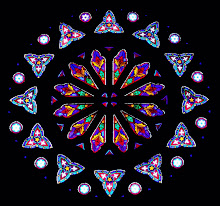
For the exercise in determining the clefs and key signature shown above, three assumptions can be made: 1) there aren’t necessarily three different clefs 2) the clefs are never ‘crossed’ 3) there is more than one correct solution.
Obviously, this is an imitative piece in three voices. Once the key is determined, consider these questions: 1) What is the range of all three voices? 2) What is the significance of the juxtaposition of the two consecutive sharp notes [dotted quarter to eighth] in measures 2, 3 and 4 in terms of conventional ‘scale’ nomenclature? 3] In which measures do complete triads - either in root position or inverted - occur as the result of the contrapuntal motion among the voices?

4 comments:
I love these! I immediately thought b minor based on the need for 2 sharps to return to the tonic (although of course other tonalites require this). Tenor, treble, Mezzo-soprano clefs would therefore be the clefs that would match.
The appearance of a leading tone suggests minor and it seems to be in A minor, employing bass, tenor and soprano clefs.
Hi Justin - yes these are enjoyable. I see why you would say B minor, citing the need to 'return to the tonic', obviously after an excursion to a related key. But there is a simpler solution [from bottom up]: bass, tenor, soprano, in A minor. You'll note that my third assumption implies that 'crossed' clefs should be ruled out. The thinking here is that crossed clefs are awkward to read, and there is often a register problem which renders the counterpoint unworkable, or at least not in the intended spatial format.
After the fact, I realized that there is one other combination of clefs/key signature that works beautifully, with no crossed clefs. It actually gives us a good example of how a set of clefs can be 'transposed' to a different set, while keeping all structural relationships intact.
Hi Kapellmeister - the leading tone certainly is telling, isn't it? The accented lower neighboring tone F sharp, a decoration to that leading tone, serves as one of countless illustrations that what the world-at-large considers 'melodic minor' to be is actually not the case. There are thousands of instances in the literature where, in the key of A minor, G sharp moves to F sharp, clearly establishing that 'melodic minor' should be considered, if it is to be considered at all, the same as the ascending form when descending. Most people believe that 'melodic minor' reverts to naturals in the descending direction. Well, not all ascending scales are immediately [if ever] followed by descending motion. The truth is, the minor tonal system consists of 9, not 7 pitches. I believe the traditional terminology really serves no purpose and would best be discarded.
Regarding the 3-part contrapuntal piece, of course, A minor works perfectly. There is one other key that works just as well, but it is not what would occur to someone at first glance. By the way, I always try F, C or G major and their relative minors as a first step in trying to figure these out.
Post a Comment